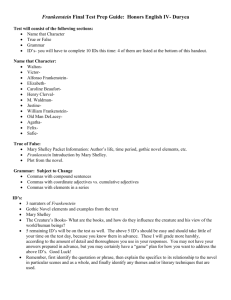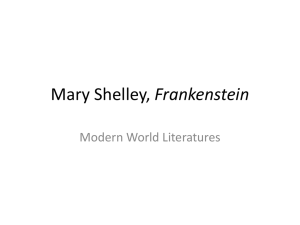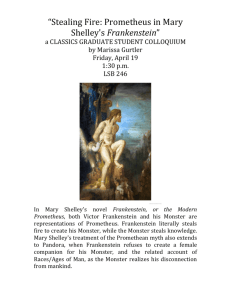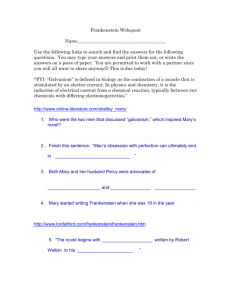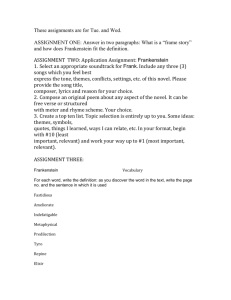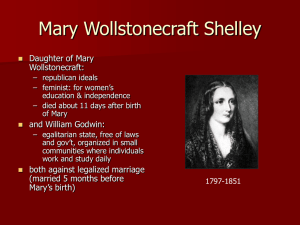A Modern Fable and subsequent retcllings
advertisement
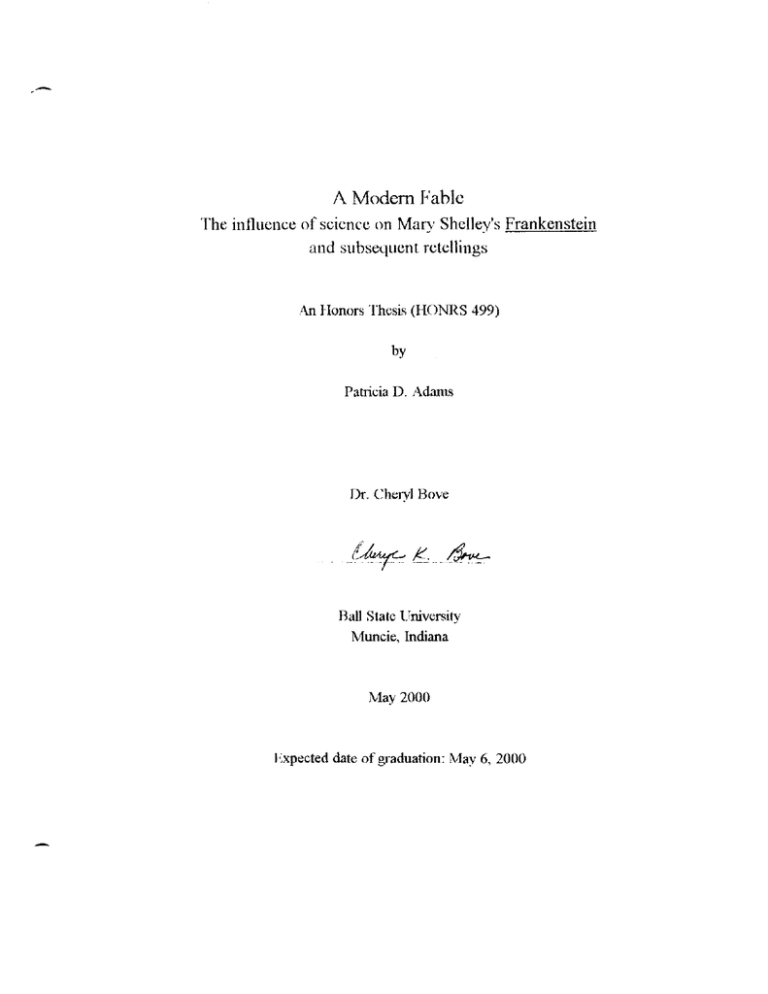
A Modern Fable
The influence of science on Mary Shelley's Frankenstein
and subsequent retcllings
An Honors Thesis (HONRS 499)
by
Patricia D. Adams
Dr. Cheryl Bove
Ball State University
Muncie, Indiana
May 2000
Expected date of graduation: l'vfay 6, 2000
L.v
;,:.W-'6 i
• :. Y
;;1..00,:)
Thesis Abstract
#
A .:~ =-~
This Honors thesis explores the science that influenced Mary Shelley'S Frankenstein and
latcr theatrical productions based on the novel, including Universal Studios'
19,~ 1 Frankenstein
and
1935 The Bride of Frankenstein, as well as TriStar Pictures' 1994 Marv Shellev's Frankenstein, It
is concluded trrat Mary Shelley'S tale, though it be b'lll1 as a Gothic talc of creation and dcstnIction,
has bcwme a table for the modem age through its seemingly endless applications to new scientific
discoveries and their effects on society. It traces major findings during the Scientific Revolution of
J 600
to 1750 in the pct1incnt tields of anatomy, physiology, and the studY of a new discovcf\"
ekctricity. It also notes scientiiic discoveries and practices in the years before Shelley'S writing of
the novel, It then surveys the theories of biological determinism and degenerationism at the tum 01
the 20th century, as well as eugenics in the 1920s and 1930s, and examines how thes" thwrie,
influenced the making of the 19311lnivcrsal Studios film. The 1935 film is examined for its
echoes of society's continuing fascination with science and technology despite their potential t,'r
danger and destruction, Finally, there is a look at the 1994 film, and how its return to the novel
its source (as opposed to springing out of another film or simply being the produd of the
screenwriter's imagination) is particularly remarkable in this present age of seemingly daily nl'"
discoveries ill the fields of medicine and gendics,
;1'
A NlDOcm fable
I
Alive anD well
I -
j1vlary
Shelley's Frankenstein is one of the most well-known stOlies of all tim". What sl,ukd
out as a manuscript refused hv publishers has, in one form or another, tound its way into man\'
faco"ts of popular culture. Hollywood has played the story out on the big screen several tinws, and
the monster has become one of the most recognizahle horror-tilm characters of all time. Costumes
fashiom:d in his image have even hecome a popular choice at Halloween. His fOlm and all it can
stand for -- fTom well-intentioned but misguided or misinj()rmed creation, to rchellion of the
disadvantaged, to vengeful destruction -- has been employed in various political cartoons
throughout the years. He can even be found, in a friendly pink, on cereal boxes -- complete with a
new name: Frankenberry. The original story has he en retold countless times in virhlally cvcrv
medium, and the very word "Frankenstein" brings to mind the unnatural, the uncontrollahle, the
undeniable consequences of any number of actions.
\Vhy arc we so fascinated with this storv? \\ by docs it hold so much meaning lor us') Is it
more than just a Gothic horror story? Simply, yes. We identiI:y with Victor (and his many
counterparts). We know the pain ofheipiessness, the longing to keep our loved ones from death.
We feel his horror when he realizes the mistake he has made, and we understand his guilt and
shame Ji)r the chaos his creation causes. We instinctively know the fear the monster instills. Yet we
also know
hi~, SOITOW
and his longing to be loved, to belong somewhere.
But beyond our shared feelings, the story of Frankenstein and his monster means even
more. It is the tale of science and society. It explores the hopes that science offers :lnd the (bngcrs
that lurk in OUf dreams of conquering death and diseast:. Mary Shelley'S Franh'nstein has becollle
for us a fitbk for modem times, inexhaustibly applicable to new theories, new discoveries, and new
dangers.
An
nnouring Nightmare
-2.-
By Mary Shelley'S own account, her enduring talc grew Ollt of a nightmare vision. The
famous story of the novel's origin was tirst told hy Mary in the introduction she wrok lor th" 1~31
edition of the novel. Percy and 7vIary Shelley, Lord Byron, ;I.,Jary's stepsister Clair" Clairmont. and
Byron's physician John William PolidOli, so the story goes. wt:rc spending a wel summer in the
Swiss Alps. One evening, Byron suggested they should each write
it
"ghost s(orv." Marv's
inspiration came to her in a "waking dream" of a monstrous creature and his tortnred creator. Th"
novel, she repor1cd, is
m~rely
a
"trans~ript"
of her vision (Shelley 196-199).
The haunting talc. however. has not the transience of a nightmare. Indeed, it has captured
the imaginations of many generations. It has refused, say CTeorgc l.evine and TT.C. Knoepllmachcr,
either to "dissipate ... into mere escapist excitement or to harden into clear and rational meaning ... "
(xiii). In this refusal it has established itself as a modem fahle. "When all is said." H.J. Blackham
explains. a fahle remains "as though nothing had heen said" (223). The image len hehind. he
contend!', cannot he replaced hy a simple meaning. "Its message can newr he, Think Ihi,' alw3"s
Think ahout this."
This inexhaustihle qU:l1ity. T evine and Knocpflmachcr say. places the novel "in a prophetIC
tradition open only, one would have thought. to mature literary imaginations ... " (xiii), celtainly not
10
a 19-vcar-old. Some haw even voiced suspicions -- prompted in palt by the fact that Ihe
introduction to the I RI8 edition was wnt1en not hy Mary, hut hy Percy Shelley -- that he. not
Mary, was th" primary author. The idea that :\1ary Shelley wrote such an enduring Hm:d,
however. is nut quite so infeasible as it may at tlrst appear. Marv had quite a background. as
Levine and Knoepllmaehcr note. In her consciousness were the philosophies 01 her !ithcr. ".'i!bm
Godwin --
hi~.
philosophies
in~quality
utopian theoric's ofthe the n:generation of hum ani tv (St"lTcnhurg
th~t
14~),
his politi"",
held that social institutions wen: restraining and merely maintained arhitrary
and that anarchy would usher in a new agc where death and disease would be haaish"d
and overpopulation would I,.. conquered (StcITcuburg 149-150. 158), and his educational theories
that cndorscu mind over matteI, that held that all individuals ought to he left to the progress of
their own mind and should he free of coercion of any sort (Knoepflmacher 118-119). Her mind
also echoed with ideas gleaned from the writings of her dead mother, Mary Wollstonecral1 -- such
A M£Xlern fablq
as her rehdlious Wlitings in "Duty to Parents," from A Vindication of the Rights of WO!)1an, m
which she encourages disohedience oftyrannical fathers (such as Godwin), saying that blind
obedience is weekm:ss (Knoep1lmachcr ')0), and her Wlilings on the French Revolution, in which
'he heralds tbe radicals (Sten-enhurg 1()2) "Iary Shelley's intellect was filled with science she
learned from Percy Shelley and with the world views of the radicals Shdky and Byron. lIer moral
outlook was fonned in this same sphere (Levine and Knoeptlmachcr xiii). And fl·om that mind so
crowded with extraordinary ideas sprang a talc that has lingered in the minds of many for nearly
two centuries.
Marv Shelley could newr h,lve imagined the long lite her talc would have. She 111"'1 lit ,..1\
did not sit down with the intent of w1iting a fable ff)r future generations. Surely ;myonc would be
daunted bv such a purpose. But though it mav not have hegun as such, it has assumed that rok.
and with each new application that role is reinforced. For such general application beyond a story's
O1iginal purpose is characteristic of a fable, Blackham says (xiv). Fahle, he says, is defined bv a
paradox: a particular action with general applications, a scenario that "is seen to transcend histnnc
time and place to represent what is" (179).
Rut how did a Gothic horror story hecome so transcendent. so ingrained in the 1110dern
mind? Mary Shelley contended in her introduction to the 1831 edition of the novel that she saw it
as nothing more than'l "tiresome" unluck" ghost story" (Shelley 199). Yet over and owr the laic
has intrigued new generations. The key to understanding Frankenstein's life as a fahle is compaling
Mary Shellev's world with the worlds reflected in various reincarnations of the storv. The factor
th:!t
se~ms
to emerge time and ag:!in is science.
111 the Miost
of Marvels
.. 'j ..
,\1ary Shelley lived in a world of exciting new scientific dis(;()veries, of rapidly expanding
knowledge of the workings of the world and the creatures in it. Successiw gClleratiol1s 11a,,, ,,;.sily
identified with such a world because. since Mary Shelley'S time. scientitic discoveries hilVc been
made with increasing frequency -- and have (;()ntinued to affect people's lives il1 n:ays
\','it~
'shieh
they arc' often not entirely comfortable.
The explosion of sci mtifi c knowledge that so intligucd people like Bymn and the Shell,""
had its beginnings in the later days of the Renaissance. Gloria K. Fien) plac_""
th~
beginnin,; ,;f tho
Scientific Revolution about 1600. and extends it to 17S0 (3: 42). Dunng this time cxtraordinan'
leaps were bting made in vaJious scientific fields, most notably, in regards to Frankenstein, in the
fields of anatomy and physiology, as well as the study of a new discovery, dcctrit:ity.
Long before thc Scientific Revolution. around 1500. I >conanlo da Vinci made detailed.
amazingly
ac~urate
drawings or the bones and muscles of men, animals and hirds (Shepherd 5] ).
Ilowewr. his notebooks were not published until 1R98, and his contemporaries were largely
unawar~
01 hi" scicntitic
insighl~
(Fiero 3: 52). The first great advance in anatomv came m 154,
when the Flemish physician Andreas V csalius published his De humani corporis bbrica. an
illustrated
tr~alise
on anatomy that he produced by dissecting cadavers to obLain an accurale
understanding of the workings of the human body (Fiero 4: 42; Shepherd 48).
Tbe beginning of modern physiology came in 1628 when William lIarvey published his
Excrcitalio Anatomica de Motu Cordis et Sanguinis i!L{\ni!)1a]jll.us. in which he colTeetlv traced
th~
path of till; blood tluoughout the body and through the heart (Shepherd S3).
~'otablc :;!~:Jc" :~
physiology in the I Rlh and and carly 19th centuries include Spallanzani's studies of digestion in
177(' ami respiration in 1790. and Sir Charles !le\1\ work on the nLTVOUS system in 1RII
CShcphcrd 62, 6·t () 7).
Teehrology was also aiding scientific discovery. In 1610 Johannes Kepkr perfected the
compound microscope (Fiero 4: 42). The tirst drawings made by the usc of a compound
microscope were published in 1625 (Shepherd 53), and in 1655 Robert Hooke published the lil'sL
important book about microscoJlC work, Micrographia (Shcpherd 54).
The year that Fiero cites as the approximate beginning of the Scientific Revolution, 1wn.
was also, according to Walter Shepherd. the beginning of the Modern Period in SCLcntLtte thonght
(Fiero 4: 42;Shcpherd 51). It also marhd the public debut of a new force in science -- electricity
The vcry word, in fact. was horn that Year. coined hy \~'i!1iam Gilhcrt to """"ri"'" !h" pro!'ert\ ii,."
amher :md other suhstances fake on when they are mbbed -- the ability tn attract light ohjects or
what we commonly call static electricity. He derived the term trom the Greek word t()r amber.
"ekktron" (Shepherd 51). In the same year, Gilbert published De ,,{agnek, a summary
,'~
knowledge of electricity and magnetism. In 1729 Stephen Gray and Gramil Whcder diswvcrcu
electric .;tuTent, and Gray published lists of conductors. At around the same time be ",prt'sscd his
opiuiun that lightning is an electric spark (Shepherd 59). Denjamin Franklin. pmhahly the iO",,;
wdJ known of all those who took an interest in electrical experiments. pnblished his
J~.xperiments
and Observations on Electricity camed out at Philadelphia in 1751. The next vear he pr('\"d th··
hypothesis that lightning was an electric spark by way of his famons kite experiment (Shepherd
(0).
On the heels of such an explosion of scientific knowledge, scientists and physician;, of
Marv Shellev's time must have felt. much as we do today, that anything was within reach, perhaps
even control over death. In 1780, the Italian physician Luigi Galvani observed the \iolent1\'.·itching
oj" the kg of a dissected frog when one of his assistants touched a nerve with his scalpel whik
,moth,"!" assistant was producing sparks from an electrostatic machine neaThv. ('alv;mi 1Tl)(lfte<l this
electllcit!li~L~'11l1Qtl!Jnuscu.!.;lri
in 1791 (Shepherd (4). Knowledge of animal cleCl1iCllY -- the
electrical basis of nerve impulses in animals -- is still an imp0l1ant pal1 of neurophysiology today,
-
but in the era out of which Frankenstein was born, the word galvanism implied the release, through
ekctricity, of mystcIious life fClfces. "Perhaps," Mary Shelley recalled of her talks with Byron
;111<1
Perc\' Shdlc\. "a corpse would be reanimated: galvanism had given token of such things" (Shdb
198).
Physicians or the time also explored the line between lilt: and death. attempting
1"("H";;t~lr
[0
drowning victims throngh valious mdhods apd to rest(lfl' life to lhe recently dead hv
means of electricity. When Percy Shdley's first wife, Harriet, drowned in J ,(mdon in 1816,
rescuers took her body to a fc·cci\.ing statio1l
\~hcrc
"smelling saIl>., \igorrllls shaking. ckcllicin amt
artiticial respiration with resuscitation bellows had been used since the 1760s to restore drowning
victims to life" (Frankenstein: An exhihition). '"nen these measures were succcsslill in rc\;ving
some rir:)wning victims, it was as if they had died and heen hrought back to life .. ~11 al1 t 'tn!'ts
":',""
unsuccessful with Harriet, however.
Jl\ the time :\lan' and Perc\' Shellev were married alteT Harriet's death in Decem ncr I XI I'.
\'lar:: had already borne Perc\' two children. However, her bahy daughter, horn in
Febm~'~' ~ 3 1 ".
di"d ks:; than two weeks 1al<:1'. In h"rjoumal, Mary wrote in March 1815 thai sh" had drcallIed oi
the bahy being held hefore a fire. rubbed vigorously and restored to
lite (Seot1 Xviii).
ivlary
q;emS
to haw been hallnted hy the ,;sk of deilth that comes with birth -- something she had known Ii'om
the very begitming of her life, when her own mother died from a retained placenta cleven days
after the difficult birth (KnoepflmachcT 92).
-
Thus while Man' Shclky's novel came out of a world imbued with ever-increasing
"'jentilk knowledge. it was also shaped hy her own t,xpcliences with
li1e and death.
It was ti111h<T
inlluenced bv her education and her reading. and retlected a culmination of ideas she absorbed
from her mother's writings, her father's social and political theories and Percy Sl:dky. !t '::1'
product of a ,;ummer spentlis1cning to Shelley, Byron ami Polidori discuss the new sCIences
~!':.-
(JI
validity ot his undertaking. voicing to Walton the hope that perhaps another may succeed "h,-",'
tiiled. Thus in the noYel the reader is not given an easy answer. The
story;:J~o:
]1,
t '\:c':!
principk," but ratlwr, as Blackham says all fables do, "it serws its PllIllOSC by exposure
(1
III
I),'
:l ::: .. : .. '
dwug)JI
Ol). '\nd as gCI](:rations have bleed new discoveries and new technologies -- and the crist', 'IlCb
knowledge otten produces -- they haw repeatedly TIltncd to this story of science and ;",c;dy Ii"
help m coping with their world.
It took only a few years for Mary Shelley'S "ghost story" to catch the public imaio"'dtioll.
\o;,."rdin,\ 10 Donald (ilul.
11,~
il'd', dramatic
possibiliti~s
were reCOgnized soon after the lirst
plinting of the novel in lS 18. Ideas for staging the story were ahandoned, according to Glut.
because the assumed author. Percy Shelley, was too controversial (28). Dut by the lime ,,1' FeTe.'
Shellev's death m 1X22, Marv Shellev was alreadv widelv acknowled!1.cd as the author «(Hut 2X).
appearcli on stage in
'Il
least five diHcn:nt versions, including a produclion allhe hngiish Upera
House entitkcl "Presumption: or, The Fate of Frankenstein." The play was insl'ired hy tb' P,,\.·,·I
hut dep'-lt1cd (i'om it frc.e1y, simplifYing thc settings and modifying the storyline (Glut 28).
Shd1e, herself ,ltktKkd a
PGll(mll'lJl~C (,[,
thl play ;l1Id later (onuncntcd:
But 10 and behold! I found mysclf famous. 'Frankenstein' had
prcdig!('~l>
success as a drama, and was about to be repeated, tor the lIvenly-lhird
night at the l'ng1ish Opera House..
. The story is
BPi wdll";lI1:'~/,1
1 was much amused and It appeared to excIte a breathless
ca~crne"s
in
the audience. (qtd. in Glut 32)
Thus bGgan more than a century of retdlings.
ffemkel1steil1 Meets the war/a
- 5-
In j 93 L ,tiler ncar" a dozen major stage producltons (serious rctelhll~s
<IS
h!ricsqu'cs and farces), and three silent films, including Thomas Edison\ versicn
well '"
c: 1()~ 0,
~vliU)
Hollvwood reintroduced Frankenstein and his creation 10 the world. The Universal Studios movie
almost instantly became a classic of an inIant geme -- the horror mo,~e -- and Boris Karlojf a
widdy unknown though expelienced stage actor. gained star stalus with his porlraval 01
Frankenstein's monster (Frankenstein: '\n exhibition). The
m()\~e.
ba,;,,<1 on Pcggy 'Yehling's 1<)17
theatrical adaptation of the novel. earned rave rcvi"ws, was named to top-len lists. ,,,,,I v,;u" ,;
more than $12 million in Depression-era dollars (t):ankenSl,'ii1l:...A.!LC3mPitiOll; (jlut 11 <}-110).
Universal's "crsion of the story inarguably departs trom the original novel. Some of th~
dlanges, such as Frankenst"in's name S\l<itehing from Victor to Henrv. O1iginaled in Wehling's
drama (Glut 42). Much ofhcr original script was retained or moditled little hy Universal in the
making of the movie, including the scene not tound in (hut not out of character with) the nO\d in
which the creature meets a young girl by a livcr and inadvertently drowns her (Glut 45 l.
Pcrhaps the most obvious abcl1"ation l1"Om the novel is the charackriz:llioll 01 lhc
crca!~)T.
Instead of Mary Shdky's intelligent. ,,,nsitive, articulate creature, Universal's executives (k"i,kd
thai the creatllre in thdr film would nol speak. His only verhal communications would he " I,'"
ofthc stor\". thc English Opera House production mentioned ahove. the creature tlad heen \, Il1l()UI
the ability to f:pcak. The Demon, as the creature had been called in "Presumption: or. The Fate of
-
Frankenstein." could 'mho gn 'nt. leading 10 mi"lt1(krstandinf' and haIred despite his atkmpls to ,'d
kindly (CJlut 31).
A 1'v1o()em hIb!e
~l
The ex,ecutives' decision in mid-1931. however. marked a maior change Iro111 the (>lWl'lat
concept of thclilm. The 1\Jonster, to be played by Bela l.ugosi. was described ir. the
J!.!!K 1 .~.
1931, issue of Tele"ision as "a weird creature resembling a man of the neanderthal ,w,e whose
mcnt:llity is astounding in some respects but whose he an
i~
9~)
that of a monstcr" (qtd. in crillt
;a~;"
But when cxe"ulivcs told Lugosi of their r"vised conecpt of the Monster, indudin!,; hi"
,,1
speaking ability, Lugosi, who had already experienced stardom in his native Europe and, thanks to
Universal's Dracula, was enjoying fame in America as well, refused the role. lIc !cft the
production, and with him \Vent the Oliginal directoL Robc11 Florey (Glut 95).
Florcy, however. had already mack imponant contrihutions to the 111m 1Ie
most oflhe storv and added many of his own idcas to the plot (Glut
(5).
h~d
hl()c:ked
0111
The dim,,:,;;1" :he Iil;.;.
the WlIld,TI111 scene, was his brainchild. (jlut reports that the inspiration c"me to Florev as lle slarw
out of his hotd window at the Van de Kamp's bakery, with its windmill trademarL acfl"":
!~,:
street (95).
The most notable change Florey made to the storyline, however. was a product not mep·ly
of his imagination, hut ofthc world in which he lived. llndouhtedly influenccd bv the
"scicn~c"
"r
eugenics and the theory of biological determinism. Florev conceived the placement ot a climinal
brain in the Monster's skull, instead of the brilliant mind Mary Shelley had en'1,icmed
Whereas Shelley'S creaturc turned to murder motivated by revenge a.tkr hc
W<lS
I(
:I[l! <l< \
spurtlcll lJ,\ hi,
creator. audiences in 1931 would see the Monster \vith his abnorm:ll hrain as prcpl"Opr'"'lm("d In
comnnt horrible acts at vIOlence. A new storyteller had once again shaped Shelley's centurv-old
tale of ercator and created to ret1ce! '.1CWS of his time and to explore sckntific thO:J2,ht or !li~; d:l: ..
Tbe Battle Against tbe 'Abnonlla{'
- 6-
Americans at thc turn ofthc 20th century could scarcely have ignored the
OnSlalJ0hl
scientiti" (!isuJVcries. They lived in an age "distinl,>1Jished by a notable consequence dthe
ot
~rr'::'!
increase in the rate of advance" in science, as Shepherd describes it in his Outline I Ii~.L()ll_";
Science
(~5).
Just as they had in \larv Shclley's day, scientists seemed "poised I" P"T""'"''''
once-sacrosanct boundaries between life and death" (Frankenstein: An exhibition).
\Iewspapers and magazines of the age speculated freelv about one day deteating dcath ana
C:'ptUl1ng immortality through the use of artificial organs. in the 1930s, American chemist
Robe'~
E. Comish killed a dog with nitrogen gas, then rcvived it. He vainly sought access 10 IO-"cCUtco
men. in hopes of proving his power ovcr death. and his etlrlrts got widespread press coverage
(Frank~nstein:
An exhibition). Aviator Charles Lindbergh, prompted by a diag;ws;;; of hearI
disease in his sister-in-law. began in 1931 to work on the development of a "glass heatl. " a pump.
"1:1'." bnll I)Tc'.' glass, inh:nded to sustain organs outside of the body. He worked with "C"h~!
PJizc-winning French surgeon Alexis Carrel, who used th" apparatus to keep heart", kidilc;ys,
ovalics, and other organs alive for s!lld" and experimentation (Frankenstein: An exhibItIOn). The
audiences that Hocked to the theaters to see Universal's Frankenstein might have been remind",!
.
such experiments when, just bdore the animation of the l'vlonstcr, Henry Frankens[Cin lold i,is
fonner professor of how he had kept a hnman heart beating in his laboratnrv t()r tbr(,,?
~~cws
of ~ffOJ1s ;,Udl
much as galvanism
~md
a~
we('~c
those of CUil1ish and LinJbcrgh UllJOUhtl'-\.l!y intrigLH.\l t!i . : jh_;~':;<..
the resuscitation of drowning victims had tntrigued Mary Shelley and her
peers a cmtury before. Perhaps they felt a real thrill of hope when they saw Henrv
!'rankl'nc":'i:~
pat the cask'" he and his assistant had just remowd from its grave and say. "Hc's just t<"ling ..
waiting for new life to come!" (Frankenstein)
One of the most pervasive sdentific theories of the time, however, was the idea of
biological deknninism. I iere,litv, more than environment or education. the theorv went. cause(\
physic~lI.
mental and even social problems (Frankenstein: .\1] cxhil2,ilion). ,\ person';'
~'Jar:'.';t",!
,'.:."
molded by hi:; physio]ogv, not b,' his upbringing, Such vi<:ws kd to matl\' psuC,;O-SLlClIIiiiL i'l,ilus
and theones,
The .:..-.rly 1900s saw dcgcneratiunist thl.!Olics beCOlTIC popular, [~H' ..:xanlpL, .tlhl ..:!,;.~i~i-, n; . .
same time period the intlucn,;c 011 )arwill', thcon uf natural ,eicction
c()nte~:!';,
\\,;h
c:-;tcndcd to,;,;, ",I
hem:c the dc\'clopmmt 01 social Darwinism (Bowler 273; Brantlinger 3). Hcrhcrt
Spencer, a late-19th century philosopher and leading social Darwinist. coined the (elm "sun;va! ClI
the filt':st." which, when applied to society, predicted that unlit individuals would gradllalh'
he
edged out hv the supetior individuals (l3owler 214).
Degeneratiorusm, in light of this application of '~volutionary thought, was seen '\,'.
of LOO Iittk competition (lr su!Vival, and it was thought that some groups
01
pcopk bad
:~t'. ·:r~;:·:~
Ilhl(cCi /(,
('arl;er l~voJn110nary tOmls. Thl~ theory was taught in te'?t honk,: nfth(-- tinw. "P'C> nfwhll'h
the .\ lala\' or brown race hom the Pacitic islands, the American Indtan, the tVlongoitan or veHow
ra.:e including Chinese, Japanese, and the Eskimos, and "the highest type of all ihe
('~~c:\,;:,~,·
rcprcscntcd by the civilized inhabitants of Europe and Amcrieil" (qtd. in (idh 3).
This reversion or degeneration theory is also evident in a look at the history of the ,li'<::1' .
disease. and .tor whom the disease is now named, helieved that parents 01 one race coulll
(I'
a child
wh~' \\'3S
a rC'.·crsion to another race. hence (he term .'\1ongelism, !",. n:hi·,h.
~I\': :);1 ih
11, •... ".
was lotlg known (lielb 4).
[,hese thcot;cs of degcncralionislll were then extended to nlor;,lity. la,
Ill"""'" ."",,,'
f'
],,'
'.,'en as ., '.h:lraci('1';stic ilfde"cneracv ,nd added those laheled as insane, mentally dcJi,icI;L ,,,;J
socially dc"iant to the list of regrcssed glOUps (Gclh 4).
As Bowler notes. psuedo-scientific theories such as degeneracy and social Darwini"m h:nc
often b,:en misused to support harsh social policies (273). The eugenics movemtnl is
of such misuse. The term "eugenics" was adapted from the Greek word
ClIgPl1C'·.
"n~
c,.Hllpic
me;m;pf',
" .,'J, [.,',.
"wellborn" tHranthnger j), and the movement strove to better the human race thrnuoh
,,1' gem'tic principles,
,\1)J'''',' ""
Thomas;.,t Shapiro sees the mo\'cmcnt as having taken !"") ;::0'."""
dirediuIIs; one being "positive eugenics. " which was ccnlcn,d on ell,)rts to increase 'OlL'cliing
oppot1unitie~:
for what were seen as more "fit" individuals, and the other heing "negative eugenic<,"
centered on the restriction of the "breeding" of "unfit" individuals (33),
The suppOlters of eugenics, which included the likes
of
Alexander Uraham Hell.
oflhe Carnegie Foundation. and J, H Kellogg, fi:JUmkr of Kellogg Foods,
that natural sdection was not weeding out the undesirables fast enough
to
b',',_' I!, "'):!
prevent tile
cnnt'1tllinatinn oft!>" pnpnlation, :md so desired to "Ike the mattcr iptl> Ih,';"
cu~crucists
S~CI11 ti)
lllC1l11lCrS
,w, f! 1--.,-"1,, ,,,
of the carlv 20th c"lltur\' beueved that most human characteristics would be Imkc(1
directly to single genes, Thev purpot1ed the influence l'f' gcne~ in cvcrything from physical
[1',';"
"~cupalion,,l
(0),
pfcfcrcnc,,,,, to
~har:H'k"
strengths and weaknesscs (Smith. "The Deli Curw"
They saw undesirable traits as heritahk and reasoned that these could he eliminated hy restricting
the rcprodm;;:ion of indi-viduals who displayed such traits,
A model law was wrinen up, and suppot1ers of the movement were asked to present
!he le,6isbtures in their uwn ~tales. This law
Y\,3S
to appoint a state eugenics .1gent
W!'lD
11 10
''.'l'~:!~!
IJlvc::sligdlt:: lilt; h~redity of "a sOi,;idlly itlaJequak: person": this agent wuuId bi,; ~1UlhUJ i/,I...:u
II} uHiu
,
:\ .\\..ouen!
I,; H.
had followed by 1931 (Shapiro 35).
,\ Virginia law authorized the sterilization of 17-year-old
"!c·+k :nindc.j"
\~;lS
d,lUght~r
Carri~ l:lu~!" :.h~
suppucc.!!.•
of a prostitut<;, who had given birth to an illcgilimak child
raped (Shapiro 3). These restrictions were upheld by the Snprem('
(,Ol1ft
b~call,i"
in the! 'P7
,he
.ic",., ••
,\ c have seen more lhan once thaI the puhlic weltilre rna\' "ail upon the
best
citiz\.:'n~: f'R
their
liY~s.
those who aheady sap
lh~
It ,':ould be :;1rangc if it
u~uld n~)1 '.2~J] l!pOn
strength of (he Slale fiJI' these k"cr sacliiic", ...
in order to prevent onr heing swamped with incompcknc('. It ;s 1><:1(e1' I .
all
th~
world, If il1st~.ld of waitmg (0
cxe"ut~
degenerale
(j[Lrrin~
1;)1' ,;r;,·,;,.
or let them stalve t(lr their imbecility. society can prevent those who are
m;mikstly uniil lrom breeding their kind. The pr;;Kip!c !hlt
compulsory valCeinatioll is broad enough to
COWl'
Sll"U"L'
culling Ihe jililopian
lUDcs.
daughter v'vcnl on to displav hi[!ll academic potential (Smith. "Rctkcliom" 2,\.1 \.'. ':V('PtI, I".s.
""s
decision set a precedent under the authority of which it is estimalcd that at ':::1':1 <",I'llI' ;-,,:,;,1 ..
-
w~n;
sterilized in the United States (Smith, "Re1lections" 234).
',ueh was the atmosphere in which T'niversa!'s Frankenstein \\as cone,,;, ed Tht: P"T\:lSi""
tlle()f\' oj
LC1131lll\-'
hioloillcal detclminism supported eugenics. and surclv m.lde the Idea o( a
Tl'IInkT,'
i"
lrightening. Professor Waldeman, the tilm's proponent of biological dctcffilinislll. IS
brain and 111<: abnollnal brain, taken, he says, from a man who lived a lifL' vI' \,ivkll~~ ,lHJ
,,\ticr the creation of the MOllster, he tries to
com~nce
Cl HHC,
Henry Frankenstein that his ereatH)n WIll
never cvereomc his biological ancestry:
Waldel11an: Wake
Ill'
and
lo()~
facts
III
the face! Here lVe have a fIend
,vhosc brain .
J-."an}(enSrel17: ontcnupting) w'hose b1':1111 111UST be ~ri\
_'11 mi1C
to
(iCVi.-h:P:
your o\vn laboratory.
TVa/demon: The lorain that was stolen from my 1;.horat(1':' ,,,", :. "rimino11".,,,!)
Frankenstein: Oh, well. AlIel" all, it's only a picc" of d~"d (issue,
Waldeman: Only evil can come of it. , , ' Y Oil have crea1ed
and it will destroy
it
YOII"
Frankenstein: Patience. patience, I helic"c in that monsler. as
,-
mnnsler
.'\nd ifyoll don't, then
YOII
VOl!
call
11.
must leave me alone,
l'ranknstein's creation. of cours", dot;s not ovel"comt; his inf"rior Dram, lIlSLt;au. lie
I.iUliI'
his
blOlo!~icanv
predestined role. just as Professor Waldeman predicted he would. He ban!'s
F13nLcmlcin's assistant, Fritl, atier enduring his torture for a few days, :lIld he blls WaH.. m::n
before the professor has a chance to end his manmade life.
vfbiological determinism ai vFork, its outcome is perhaps even less dcfinik ill ib jU'lg)""i,i ,;"'"
hlJnseif. the only totally innolcnl \·ietim of Henrv's Monster
IS
t\lana. the IIttk ,lin
11\ III"
n' cr.
'scm petiee!ly willing to pick lip their lives as if nothing had happened at ,,11. !,ui drc Ll,<:j, ii,·"
same') Ur
Wi";
the destruction of the monster the stat1 of a new and bettcr world') Perhans
;Irnhiguous ;;lot twist min'ors attitudes of the time. >Jc\,. dif,cO';cric:; \V.'re bc;ng
IIl1S
1:;;;JC .. , cry)
:\uch evcr-increasinl" knowledge could easilv have allowed sei"ntists 01 the era h) k,i ,hey .\ ci ':
I1Jwn.a!\ Fr"n\(fnstein wtlh mllch to think abollL AtlOv ralc. '\ (alY Shelkv', 'ilk Ind om' ·d
"pplic ::hlc to ,;cicntiiic findings not
cv~n
dreamed of at its conception.
'I'"
N(~Jj~Cflll.~
-7-
I
,
l' .
~
noi CIlU "0 siml'iv. t;i'C<olur jam~s ,,,'hale had ,,,tUlned, as had Boris h"r\oil
,is
,i,,, ,~'i()1i'I'"
;11";
picked up \-vhere the 1931 movi..:: had left off. The mate that the llloastcr 11" . .1 J...,i¥u:.lh.l...J ;1', i!.v
OIiginal,torv had never been completed. but she was brought to life in l'nivers:l!" The Hmic
"I.
The ;,)onslcr had not, it tUniS out, died in the fiery ""napse of 11,<.: ",iIlumiIi ;" ':"'., ,
!'hn Bllt J knry Fr;lnkcnstein obli, ious 10 this raet. had gone OIl with his lile ! 1<" 11"'(\ "'1O'rt'1<",1
"I ill< "";'" ,,,'em to be gone and tOnl,onell. ["hal is, unlIt he gets a
1"",
)",.,~ ':~T,·ned
Ii-om his ("aching position at Henry's old
\1S11
medic~l
trom a Ur. Prclonus.
<cb(>('I'
PrdOlius. I have ventured to hop!,; tltat you amll tugtllt!,; ...
IlU lOllg~; .1'
master and pupil. but as tellow scientists. might probe the mvsteries 01
life and death ... and reach a goal undreamed of by s~icncc.
Frall1-cl1:';I"ill: f .:an', maL- am fUl1hcr c;pcrimcnts. I've had a Icnibk
le"i,;on.
PrchlJiu" That is sad, very sad. But you and I have gon~
100
far (v "ut->.
'111'1
\\ill)
nor can i!
b~ stopp~d
so easilY.
Frankenstein is pulled in. The hopes and dreams that ruled him f()r th()sc V::lrs in l~;"
lahoratory an: nut dead, and he cannot resist them. He agn,cs to work wiih Dr. l'r"iOJius.
descnhcs
!JiL:.ltdh.
It. ":Hlf
Th~
rciatlOnshlp to the technologv that we worship even as we rccoPllIze rhal
SGcncs of the creation of th~ nc\v female
CrCahll"C
:l[ain
~n1p!, )y.,::;"l
:.. ~ hi',:
1
II "
• _,
",
day. as Ihe 1931 lilm hat\. hut also echoed the science of Mary Shellev's t11ne.1 he creature 1:1",
the 131>k lacking nothing but :1 hear!. Karl, whom Pretorius has employed Ie' F:tr!'_"": I),', h
nceJcJ lor thti
\;ixpenlncnL i~
insLfuckd
10
tind a rCl..len(I~! d~ad hody Jnd
prc'lllnahiv recording the electrical impulses
: Idllh~nsk,ill'~
IIo]jywuuu
lll.. -arl
J[0111
the heart. shows thai it
tlallsplant was successful.
Th~
"Il
,t,
rCTIIOH.; II..., 11\:.tft. ill:--I":,h.. ,
IS
I..in;aLull.; wa:-;
bcalll1'-'
Ji:ti~-;\"li
\lJI '" " "'.
Ul!..t PloiUlJlIlI
up toward the sky as huge kites wcre deployed 10 capture Ihe "o<,rgy or the lightning. ccho",,,
!
\"11
Franklin's
~xperimcnts
But \':hen
th~
01 the 1700s.
"bride":()mes to life, she rejects the hiendship "f the '. k::<;!,,:·.
I..UOS m dUSlfwAion, again allowing FranKeTlstein and Elil.ab~lh Ii) cs~ap~-.
UTl(ii.tJ'11lL·;
I '.I4X. when the studio released the comed\"!h01TOr tilm .1hholand ,'osteiJo \tect j'rankt:n"c'l
((:;Iut 179).
. \Ibcrt J. Lavalkv notes lhat after that final installation of the uniwrsal ,,,ric,.
(llel C W", "
teeling that the parodv signakd an end t() the story. T! was hard. he 'avs \() scr when' Fronkrnsl{,in
l1lterprelatlOn:>. mcJudin!! Andv Warlhol's FranK£!!slein. t\·lcllirook·s '[ oung '·I""Il"cn",·,,· ,m,i
~"
n
h::m:m k"n;'·n .... dc"ircs :llld tCars ... " (285). Though he could not imaillne iT. a new hanhc!lHem
and ~ !leW manster were already being formed in the minds of his c:ontemporaries.
New Science, Same St()r~
-7 -
In 1972, it was announced that a new version of the Frankenstein tale was in the works. It
was to be a $3- million film adapted from the original novel and was to have a "sVlllpathetic"
monster (Glut 222). Its director was to be Francis Ford Coppola, whom Glut reports had been
contemplating a "definitive film version of the story" for years (222).
That definitive version, however, was not to appear until 1994. And Coppola would be the
producer, not the director. Bllt it did indeed return to the original novel as its source. It restored to
the characters their original names -- Victor Frankenstein is the young medical student; Henry
('lerval is his friend. It replaced the deleted scenes of the monster's journey after his creator
abandoned him, as weD as those of Frankenstein's sickness and delirium ancr his first meeting with
the monster. It restored speech and inteUigence to the monster, making him once again the
sympathetic character Mary Shelley had created. Death comes once again to William, Justine, and
even Elizabeth.. The 1994 film showed a Frankenstein who was by the end of the story sad and
lonely, robbed of all that had hrought him joy and hent on finding and destroying the monster he
had created.
Most notably, though, it did what no other dramatization before it had done: It retained the
.-
frame story of Walton and his ship in the Arctic, of Frankenstein's teUing of his story. It
sh<''''c;l~l·(1
once again Frankenstein's exhortation to Walton, his warning about overarching ambition:
A Mtxlern Fabie 24
Walton: Listen to mc. I have spent six years planning this, my entire fortune.
I will not be stopped by you or some phantom.
Frankenstein: Do you share my madness?
Walton: No, not madness.
Frankenstein: What then?
Walton: There is a passage to the North Pole, and I will tind it.
Frankenstein: .\( the cost of your own life? The lives of your crew?
Walton: Lives come and go! If we succeed. ow' names will live on forever.
I will be hailed as the benefactor of our species
Frankenstein: You are wrong. I of aU men know that.
And so begjns Frankenstein's tale, very close to Mary Shelley'S origjnal story, played out on the
screen. In the end, Walton, believing Frankenstein's words to be the ravings of a madman, seems
still to be bent on finding the passage to the NOJ1h Pole. When the monster appears after th" death
of Frankenstl~in, however, he realizes that his quest is too costly, and he gjves the order to tum the
ship toward home.
This film is extraordinary not in its changes from thc origjnal text, but in its return to it. In
this age of transplants of everything from hair, to eyes, to fingers and hands, of fertility treatments,
of genetic mapping and even cloning, the creation of life is apparently closer than ever bef()f"(;. III
1997, the world was confronted with the news that researchers in Scotland had cloned a sheep
A MOOern
Fable 1.)
from the
'~ell
of an adult ewe. The next year, scientists in Hawaii produced three generations 01
cloned mIce, and scientists in Japan cloned eight identical calves from cells of a single adult co\\
(The I-lislQ!Y..Qf Genetics). And in September 1999, international kaders of the Human Genome
Project, launched in 1990 to map the entire human genetic sequence (The Historv ofOcnetic s )
announced that they expect to have a complete DNA reference sequence
b~'
20lH,
t~o y~dr,
earlier than originally projected (Human Genome Project). In such a world, we need no aid to
understand Mary Shelley's tale, now nearly 200 years old. The fable needs no translation. It is
again directly applicable. And with the restoration of Walton, it seems to apply more speciii"ally to
each of us.
Frankenstein told his tale to Walton that he might learn from his mistakes, that he might
realize that his decisions would affect the lives of so many others. Once Walton saw the truth ot
the
stOf\,.
he had nn choice but to look his responsibilities in the face, as Frankenstein had refhsed
to do until it was too late. Mary Shelley gave us a tale that has proved to be applicable to cwry age
since hers. It gives us much to ponder, but refuses to give us simple answers. We as the audience
have the oPIK'ltunity to heneJit hom its history, for it is intetiwincd with our own. \:Vc have the
responsibility to learn from the past misuses of science, to be aW'are of what is going on around
Frank'~nstein's
LIS
crime lay not in his search for knowledge, nor in his act of creation. His
crime was his lack oftorethought. He neglected to stop and think on what the dtects of his actions
would be. fit; did not consider what the consequences would be for himself; his creation and th!;
world around him. He did not think about these things until he stood face to face with his creation
" and by that time it was too late. Frankenstein also wmmittcd one additional crime. I Ie rd'llsed to
take responsibility for his mistake. In doing so. he compounded his tirst '-'rime. and exposed Ihe
world around him to the consequences.
The solution, howewr, is not to stop exploration. to discontinue experimentation. to stifle
science. We can kam from Frankenstein how better to use such things to the real benefit 01
society. We should learn to look at ewry possible outcome of our actions before we act. '.'.'c
should learn to take responsibility t(n our actions and their consequences. We should kalll to
C0mmllTlicaK hdim', during, and alkr we act.
Ir wc do not \eam these things. that which we
create today will inevitably haunt us tomOlTOW. And future generations will question why we could
not glean wisdom from the past.
-
-
Works Cited
Blackham, II. J. The Fable as Literature. London, England: The Athlone Press, 1985.
Bowler, Peter J. "The role of the history of science in the understanding of social DalWinism and
eugenivs." Impact of Science on Society 159 (1990): 273-278.
Brantlingcr, EUen. Stelilization of people with mental disabilities: Issues, perspectives. and
Westport, Connecticut: Auburn House, 1995.
(;ase~.
Fiero, Gloria K. On the Threshold of Modernitv: The Renaissance and the Refol1llatiol!. Second
Edition. Volume 3 of The Humanistic Tradition. Madison, Wisconsin: Brown &
Benchmark Publishers, 1995.
---. Faith, Reason, and Power in the Early Modem World. Third Edition. Volume 4 of The
Jlumanistic Tradition. New York: McGraw Hill, 1998.
Frankenstein IThe Restored Version). Dir. James Whale. Prod. Carl Laemmle, Jr. 1931.
Videocassette. Universal Studios, 1999.
Frankenstein: An exhibition of the National Library of Medicine and the National Institutes of
pealth. 17 March 2000. <hltp:ilwww.nlm.nih.gov/hmdlfrankensteinlfrankhome.html>.
Gelb, Steven A. "The bea~t in man: Degenerationism and mental retardation, 19()()-1 920. " Ment.!!!
;Rdardation 33.1 (February 1(95): 1-9.
Glut, Donald F. The Frankenstein Legend: A Tribute to Mary Shelley and Boris Karlofl.
M.:tuchen, New Jersey: The Scarecrow Press, Inc., 1973.
Human Gmcmc Project ~- Y car Plan. The U. S. Dept. of Energy. 4 'vIay :W(lO.
<http://www .ornl. gov/T ecilResourcesiHuman(ienome/hg5yp/>.
Knocpflmacher, U.C. "Thoughts on the Aggression of Daughters." The Endurance of
Frankenstein: Essays on Mary Shelley's Novel. Eds. George Le\~ne amI I I.C.
Knocpflmachcr. Berkeley: University of Califomia Press, 1979. 88-119.
Lavalley, Alb"rt 1. "The Stage and Film Children of Frankenstein: A Survey." The Endurance of
Frankl~nstein: Essays on Mary 5helley's Novel. Eds. George Levine and u.c.
Knoeptlmacher. Berkeley: llniwrsity of Calii(lrnia Press. 1979. 243-289.
Levine, George and U.C. Knoep11macher. "Preface." By Levine and Knoepflmacher, cds.
The Endurance of Frankenstein: Essays on Marv Shelley's Novel. Berkeky- 1 'niVC'r'il~ ,,1
California Press, 1979. Jci-xvi
Lnine, George. "The Ambiguous Heritage of Frankenstein." The Endurance of Frankenstein:
Essav:> on Marv Shelley's Novel. Eds. George Lc"inc and IT.c. Knoepl1macher. Ikrkckv:
University of California Pr,,",. 1979. 3-30.
Marv Shelley's Frankenstein. Dir. Kenneth Branagh. Prod. Francis Ford Coppola. Videocassette.
TriStar Pictures, 1994.
Moers, Ellen. "Female Gothic." The Endurance of Frankenstein: EssJ\"s 011 ;vlar\' Shcllc\''s :';,)\,0·
Eds. Georg" Levine and U.C. Knocpflmacher. Berkeley: University ofCalifurnia Press,
1979. 77-87.
Scott, Peter Dale. "Mary Wollstonecraft Godvvin Shelley and Frankenstein: A Chronolo~v. "The
Endurance ,,{Frankenstein: Essa,,"s on Marv Shelley'S Novd. Eds. George Levine and c.c.
Knoepflmaeher. Berkeley: University of Califomia Press. 1979. xvii-xx.
Shapiro, Thomas M. Population control politics: Women, sterilization, and rcproductiw choic".
Philadelphia: Temple University Press, 1985.
Shelley. Mary. Frankenstein (J 818 edition). Ed. Paddy I.yons. London: .1.'\'1. Denl '" Sons i .1<1 ..
1992.
Shepherd, Walter. Outline History of Science. New York: Philosophical Library, lnc.,
196~.
Sterrenburg, Lee. "Mary Shelley'S Monster: Politics and Psyche in Frankenstein." The Endurance
of Frankenstein: Essays on Mary Shelley'S Novel. Eds. George Levine and U.c.
Knoepflmacher. Berkeley: University of California Press, 1979. 143-171.
Smith, T. Da'"id. "Reflections on mental retardation and eugenics, old and new: Mensa and the
human genome project." Mental Retardation 32.3 (1994): 234-238.
Smith. J. David. "The Bell Curve and Carrie Buck: Eugenics revisited." Mental Retardation 33.1
(February 1995): 60-61.
The Bndc of Frankenstein. DiL .Tames \"'"hale. Prod. Carl Laemmle, Jr. 1935.
Univ(;rsal Studios, 1999.
The History of Genetics. The Genome Research Project. 4 May 2000.
<http:mibrary.thinkqucst.org!28920/eng!genehist.html~ .
Video~asS(;lle.
